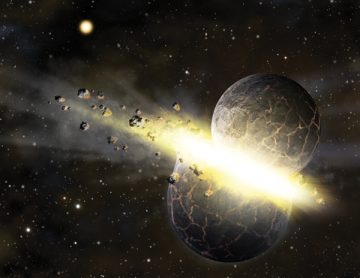Our Moon. Its Origins.

Our sky would be pretty dull without the moon, among the stars. During the day, we see our star the Sun. Its formation is quite simple. It started as a solar nebula, then gravity caused it to collapse, forming a disk, making our giant ball of fire, just like the many other millions of stars in the Universe. The moon, though, has a more mysterious backstory. There are many theories as to where it comes from, and how it has come to being. We might never truly know how, but by the end of this article, you get to choose which makes the most sense to you.
What to know so far:
All these theories start around 60 million years after the solar system was formed, with Earth being approximately 4.5 billion years old. During the Earth’s formation, it was not quite the kind of Heaven it is now. In fact, it was quite hellish. The prototype Earth collided and fused with other prototypes. The planet was filled with lava and tons of molten rock. The young Earth spun faster, meaning it had shorter days. Being inside the planet during this phase of its life would only see chaos. The moon was no different. The black spots we see on the moon are actually fossils that were once pools of lava.
Theory One – The Giant Impact
This theory is the most common and believed. The Giant Impact theory, beloved as far back as 1970, starts with a body of rock or an asteroid called Theia. Theia, being as large as Mars, headed towards Earth at high speeds. Then BOOM, it smashes against the young planet. This causes Theia to become split into pieces, alongside a small portion of Earth’s surface of molten rock. The rocks started to circle Earth into a disk, similarly to Saturn’s rings. After some time, the leftover pieces fused to make the moon we know today. This theory might make sense at the beginning, but this theory has a flaw. Apollo 11, which was the first spacecraft that landed on the moon, brought samples of the moon back to Earth. The minerals and chemical compositions that were in the rocks were identical to Earth’s. The moon and Earth were like identical twins. If the Giant Impact theory is correct, then that means Theia should have had the same minerals as Earth, even the same atoms. But again, it is unlikely since we have not discovered any planet or body of rock that has something identical to our planet.
 Theory Two – The Fission Hypothesis
Theory Two – The Fission Hypothesis
On this idea, the prototype Earth was spinning on its axis insanely fast. Faster than what is predicted. Because of its speed, part of the planet somehow separated or spun off from it, forming the moon. The region that would have most likely separated from the young planet might be what is now the Pacific Ocean. This odd idea can explain why the moon is similar to Earth, but the Pacific Ocean is too young to be the birthplace of the moon. Plus, there has not been any clear evidence that the young-rapid Earth has ever existed.
Theory Three – The Georeactor
The hypothesis has more of an explosive view. The developing Earth would have had an abundant supply of radioactive chemicals, like uranium. This was able to pile up because of the Earth’s quick rotation, causing a centrifugal force. All of a sudden, BOOM. A very, very huge nuclear explosion sends out materials from Earth into outer space. The materials came together by gravity, orbiting the Earth, making the moon. Similarly to the Fission Hypothesis, it can explain the Earth and moon relationship, but many scientists doubt that a nuclear explosion that ginormous is even possible.
 Theory Four – The Synechia Theory
Theory Four – The Synechia Theory
Bringing back Theia, the theory has the same idea as the Giant Impact, but with a major twist. Theia still crashes onto Earth, but it completely obliterates it. The impact of Theia was so strong, it vaporizes everything, even the rock. The “vaporized rock” then makes a doughnut-shaped cloud, with Earth changing again in the middle. That would mean that the Earth was once a gas planet, like Jupiter. The moon then would form alongside Earth, orbiting it inside the synechia, and be hidden from view, until the synechia cools and shrinks back to Earth. This theory completely changes our point of view of Earth. It still goes unapproved, but it can be our best answer to the origins of the moon.
Our moon might look like any other body of rock orbiting a planet, but ours is odd – in a good way. It is surprisingly bigger than other moons. It has that perfect-looking sphere, with the ability to seem like it is glowing. Kind of hard to imagine a night sky without it. Wherever it came from, we doubt it was made easily, just like its twin, the Earth.
The reason I joined is that I enjoy typing/writing stories and I knew that in journalism, you do that alot, but never was able to do journalism class in...








